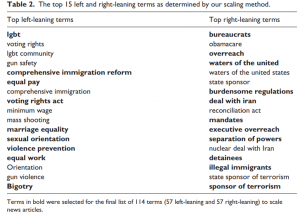There’s a clear link between the accounts journalists follow on Twitter and the partisanship of their work, finds a new study from researchers at Northeastern University and the University at Buffalo.
The more left-leaning Twitter accounts a journalist follows, the more left leaning his or her writing tends to be. Reporters and columnists who follow a lot of registered Democrats and Twitter users affiliated with the left generally use more “left-leaning” terms such as “marriage equality,” “bigotry” and “comprehensive immigration reform,” the researchers find.
Likewise, the more right-leaning Twitter accounts a journalist follows, the more likely he or she uses “right-leaning” terms such as “burdensome regulations,” “illegal immigrants” and “Obamacare.”
John Wihbey and David Lazer of Northeastern and Kenneth Joseph of the University at Buffalo teamed up to investigate the relationship between journalists’ social media networks and their written work. They focused on journalists’ networks on Twitter, a platform that has become an integral part of the news gathering and source building process.

The researchers identified 644 political journalists from 25 news outlets, including the Wall Street Journal, Dallas Morning News, Arizona Republic, Huffington Post and Breitbart News. They analyzed the Twitter accounts these journalists were following as of May 2017. They also examined the journalists’ published work up to that point in time, searching for 114 terms the researchers say represent either a strong left- or right-leaning ideology.
Wihbey stressed that he and his colleagues found no evidence that following certain accounts causes journalists to write in a particular way. But they discovered a correlation between the partisan leaning of journalists’ Twitter network and the political ideology reflected in their published work.
Wihbey suggested journalists consider how they spend time on Twitter and the kinds of information they get there.
“I think everyone who’s on social media these days, we sort of tend to follow people and institutions and outlets kind of one by one,” said Wihbey, a former managing editor at Journalist’s Resource. “In these sort of small decisions, which accrue over time, we’re perhaps doing something more consequential in the aggregate. I think that’s perhaps what we, as journalists, ought to reflect more on.”
The study, titled “The Social Silos of Journalism? Twitter, News Media and Partisan Segregation,” was published in the journal New Media & Society in late October 2018.
Here are some of its other key takeaways:
- When the researchers looked at the behavior of journalists from three large legacy newspapers — the New York Times, Washington Post and Wall Street Journal — they found the publications tended to produce “fairly ideologically neutral or even fairly conservative content,” despite accusations that they have a left-leaning bias.
- There were exceptions to the trend the researchers found. For example, David Sanger, who covers national security and the military for the New York Times, is “among the most right-leaning content producers, even though his Twitter network is among the most left-leaning,” the authors write.
Looking for more research on journalists’ use of Twitter? Check out our write-ups on political journalists and “gendered echo chambers” and on the online harassment of female journalists.
Facebook and the newsroom: 6 questions for Siva Vaidhyanathan
